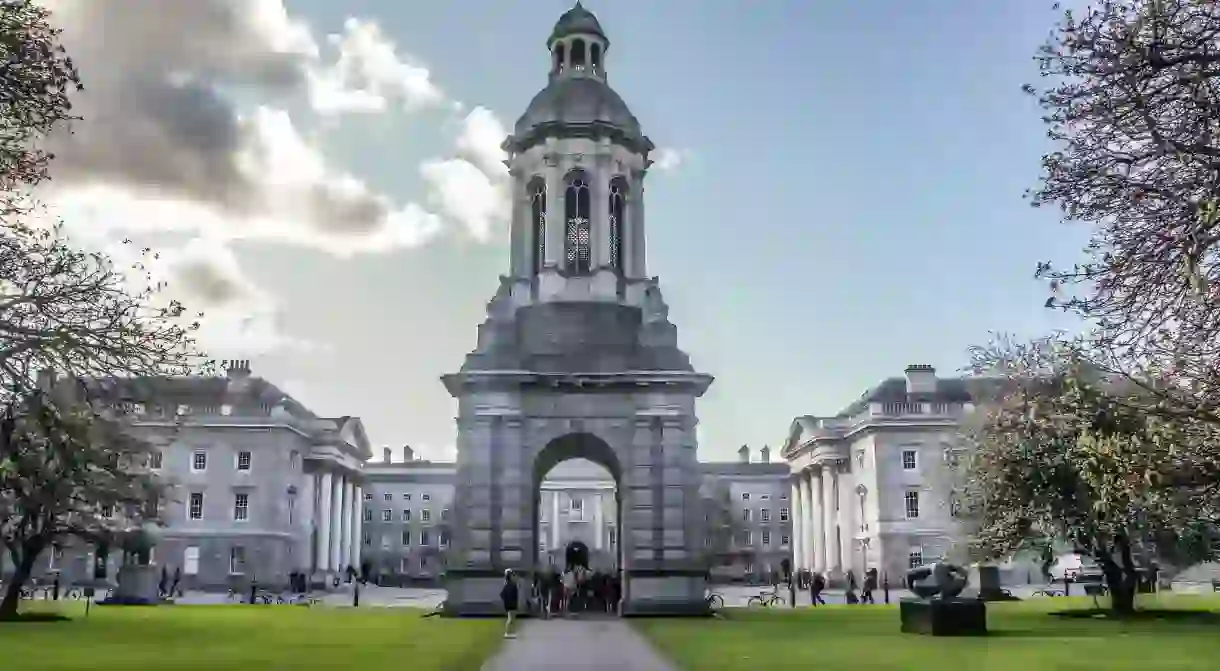10 Facts You Didn't Know About Trinity College Dublin

Trinity College Dublin is Ireland’s oldest high-level educational institution, and is best in terms of rankings. Founded in 1592, it has produced some of Ireland’s best-known literary personalities – like Oscar Wilde and Samuel Beckett – as well as political figures such as Theobald Wolfe Tone, Henry Grattan and President Mary Robinson. But this prestigious university still holds some secrets.
It wasn’t Ireland’s first university
Although often referred to as Ireland’s oldest university, Trinity wasn’t the first established in Ireland. In 1311, Pope Clement V was petitioned by the then Archbishop of Dublin to issue a papal grant for Dublin’s first university to be built. The Medieval University of Dublin was established in 1320, but suffered from a lack of funds throughout the next two centuries and disappeared during the Protestant Reformation.

It began as a monastery
Trinity College was established on the grounds of a former Catholic monastery – namely the Augustinian Priory of All Hallows – that had been disbanded by King Henry VIII as part of the Dissolution of the Monasteries. In 1592 the Archbishop of Dublin at the time, Adam Loftus, and several others requested a royal charter from Queen Elizabeth I to create the university there, in order to train new clergy ministers and strengthen the Protestant Reformation.
It wasn’t always in the city centre
Though now at the heart of the city, at the time of its founding Trinity College was actually located outside and to the east of the walled city of Dublin. As the population grew and it developed into the capital, the city limits spread rapidly. During the 18th century redesign of Dublin, the surrounding areas of Dame Street, Westmoreland Street and D’Olier Street were established through the widening of formerly narrow, medieval streets.

It was intended as the first of many colleges of the University of Dublin
Archbishop Loftus was a graduate of Trinity College, Cambridge and hoped to create a similar collegiate model in Dublin, down to naming the first college after his beloved alma mater. But while the University of Dublin did expand greatly over the century following its inception – thanks to grants from the then Parliament of Ireland, conveniently based directly opposite the campus – no other constituent colleges were ever established.
Its student body was split by Ireland’s rebellion against the UK
In spite of its connection to the Protestant Reformation in Ireland, several prominent Irish nationalists were Trinity College graduates. Theobald Wolfe Tone led the 1798 rebellion and is seen as the father of Irish republicanism. He died aged 35 in a Dublin prison. Robert Emmet led another rebellion against British rule in 1803, for which he was executed on charges of high treason. Politician Henry Grattan campaigned for legislative freedom for the Irish Parliament, while the first president of Ireland, Douglas Hyde, was yet another Trinity graduate.

The Catholic Church banned its members from attending Trinity for nearly 100 years
Trinity College opened up attendance to Catholics in 1793, during the Emancipation. However, even after they were permitted entry to the college, non-Anglicans were still prohibited from gaining positions of prestige within the university – such as becoming a scholar, fellow or professor – for another eighty years. Just prior to these rules being removed, the Catholic church banned Catholics from studying at Trinity in 1871. The ban lasted until 1970.
Its students are afraid to pass under the campanile
The iconic granite campanile – or bell tower – in Trinity College’s front square was added in 1853, standing over 100 feet tall. Tourists flock to this picturesque monument facing the college’s front gate, but students are somewhat more cautious, due to a superstition that states that any student who is unfortunate enough to pass underneath it while the bell is tolling will fail their college exams. On graduation day, a celebratory walk under the campanile is a rite of passage.

It has several of its own urban legends
There is a long-standing rumour that Trinity College ‘scholars’ – students who are selected based on a special set of examinations and given special treatment, such as free city centre campus accommodation – are, by an old law, still entitled to ask for either a glass of brandy or a pint of Guinness – depending who you ask – during their exams. Another version of the mythical law specifies that said student must be wearing their sword at the time.
It has a copy of every book printed in Britain and Ireland
The library at Trinity is entitled – due to its status as a legal deposit library – to at least one copy of every publication, free of charge, that is published in Ireland. It is also entitled to any book published in the UK upon request. Established at Trinity in 1801, legal depository status has earned the library a stock of over five million books, mostly held off campus but available to order. Trinity alumni continue to have the right to use this incredible service after graduation.

Its students have unlimited access to the Book of Kells
Trinity College students have another cultural advantage in that they can view the Book of Kells – aka ‘Ireland’s finest national treasure’ – free of charge any time they like. The ancient, illustrated manuscript containing the four gospels has been on display in the college’s Old Library since 1661. Entry to view it costs members of the public a fee from €9 upwards, but Trinity students visit for free.













